Vegetation that gave rise to the White Cliffs of Great Britain is found to trap carbon in the Southern Ocean, says S.Ananthanarayanan.
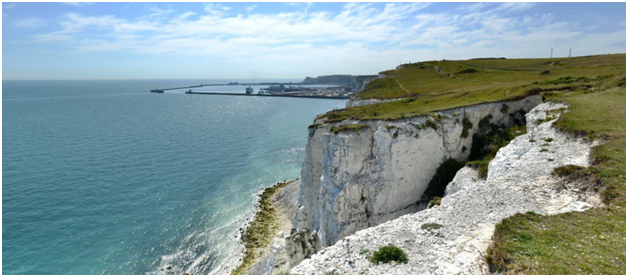
The first record of the white, southern face of the British Isles at Dover, and along the coast, is by Julius Caesar, when he found this nearest entry from France to be too well guarded. The cliffs have long served England as a first defense against invasion and they now enclose a network of tunnels and chambers, which housed a hospital during World War I and troops and a command station for the Battle of Britain during World War II. While a large part of the British Isles consist of the same chalk deposit, the chalk strata continues across the channel, and can be seen from atop the cliff at Dover, at Cap Gris Nez on the French coast.
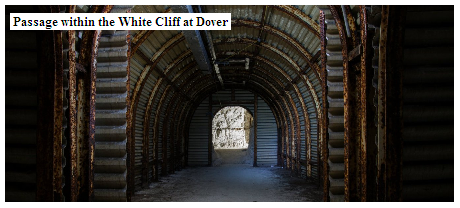
The chalk deposit is known to be the skeletal remains of algae, or phytoplankton, photosynthetic organisms found in the sea. Some hundred million years ago, this part of the earth was submerged by water and the hard, outer remains, called cocoliths, of a variety of seaweed, descended and gradually formed a 500 metre mound on the seabed, a mound that rose above sea level, as the British Isles, due to movements of the earth’s crust. A group of scientists from Bigelow Laboratory for Ocean Sciences, Maine, the Bermuda Institute of Ocean Sciences, the University of Southampton, the Woods Hole Oceanographic Institution, California and MIT, USA, have studied a vast growth of cocolith creating organisms, collectively called the Great Calcite Belt, in the Southern Ocean, the sea south of 38°S and till 60°S latitude. They describe in the American Geophysical Union journal, Global Geophysical Cycles, why the Belt arises and the conditions that allow the algae to flourish, which suggests the conditions in which calcite of the White Cliffs mound may have come to be.
The cocolithophores, as the single-celled algae are called, create crystals of calcium carbonate which enclose the cells as an exoskeleton. The scale formation is by the reaction of calcium atoms with hydrogenated carbonate, an alkaline combination of carbon dioxide gas and water, a product of photosynthesis. Of the two carbon atoms consumed in the reaction, one gets fixed as calcite, and the other is released as carbon dioxide. While some of the CO2 is again used for photosynthesis, reducing the alkalinity and releasing CO2 has the effect of sending CO2 back to the atmosphere. The net effect, however, is to fix carbon as calcite. The calcite shells are partly shed during cell growth and fully when the cell dies, and they sink to the seabed, effectively sequestering carbon.
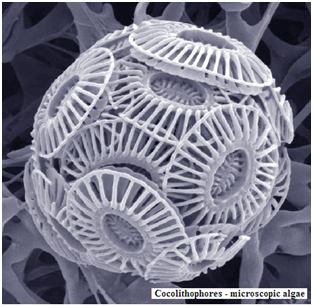
Great calcite belt
The oceans hold fifty times the quantity of CO2, compared to the atmosphere, and nineteen times more than all the biomass on land. Apart from carbon dioxide dissolved in seawater, the organisms in the oceans convert some one third of the emissions by human activity into organic matter, and also into inorganic particles. The organic matter enters the oceanic food chain and some comes back into circulation, but a good part of the carbon is released at great depths, where it remains, because water under pressure can hold more CO2, and the rest sinks as dead tissue. The storing of carbon as calcium carbonate by some organisms, however, is in addition to organic matter, and this forms an important reservoir for carbon, so long as the calcite deposit is at moderate depths or covered by other sediment when it is at great depths.
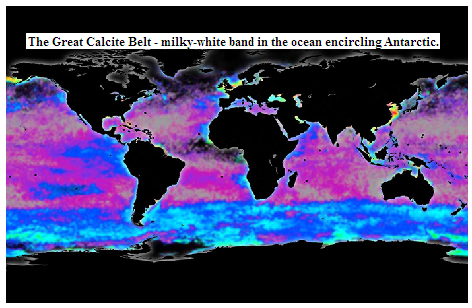
Satellite images of the sea around Antarctica reveal, during the summer months in the southern hemisphere, a milky white band, covering a vast area equal to 16% of the global ocean. William Balch, the lead author of the present study, and others in 2011, identified the band to be caused by sunlight being reflected by minute, shiny white spheres, of algae covered by a calcite shell, below the surface of the water. The imagery shows that 26% of the global particulate inorganic carbon is found in this area, which makes it largest concentration of cocolith producing algae. The study now undertaken, with two research cruises to the Southern Ocean, was to refine findings of the location, timing and magnitude of particulate inorganic carbon formation, ratio of the inorganic and organic carbon capture and the role of the process in the global carbon cycle.
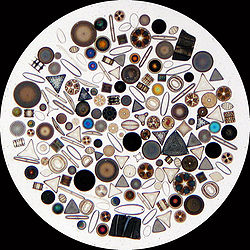
The abundance of inorganic carbon particles in the region indicates that the algae that create cocoliths are able to dominate other kinds of algae in this area, the study reported in Global Geophysical Cycles says. The main competing form is that of diatoms, which create a silica shell, and need silicon and nitrogen for growth. Cocolithophores would hence dominate in silicon poor waters. Another factor that affects growth of all algae is the supply of iron. In fact, there is a view that the oceans could be seeded with iron to promote growth of plankton, to draw down the CO2 levels in the atmosphere. Although low iron thus affects cocolith production and the Great Calcite Belt is deficient in iron, cocolithophores were less sensitive and could dominate iron-poor regions, the study says. The study also notes that the ocean currents meet along the calcite belt, which suggests that rising nutrients from deep waters, and the ratio of silicon to nitrogen content, at these places affects, the growth of cocolithophores.
The study also notes that the pace at which inorganic (ie, calcite) or organic (ie, plant tissue) carbon is produced affects the CO2 concentration. Inorganic carbon production raises the CO2 content of the water and hence diffusion into the atmosphere. Creating organic carbon, on the other hand, consumes CO2 and reduces its level. The CO2 content of the atmosphere is thus sensitive to seasonal variation of particulate inorganic carbon generation, the study says.
There are other studies that show there is actually collection of calcite deposits directly below the Great Calcite Belt, which makes it clear that the study of Balch and others have arrived at the conditions that would have prevailed at the time the calcite deposits of the Dover White Cliffs arose. There is no saying if a similar growth will arise in the Southern Ocean, but it would take many millions of years, in any case, the authors are reported to have observed.
------------------------------------------------------------------------------------------